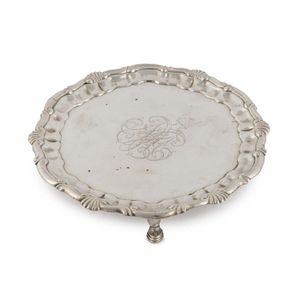Georgian Sterling Silver Salver by George Smith III
You must be a subscriber, and be logged in to view price and dealer details.
Subscribe Now to view actual auction price for this item
When you subscribe, you have the option of setting the currency in which to display prices to $Au, $US, $NZ or Stg.
- Georgian - As an English stylistic period, Georgian is usually taken to cover the period from George I (1714) to the Regency of Prince George (1811-20), although the period from 1800 to 1830 is sometimes designated as the Regency period. During the Georgian period the great English cabinetmakers and designers such as Chippendale, Hepplewhite, Adam Sheraton etc., were all active.
Therefore there isn't a single 'Georgian style' as such and to say something is 'Georgian', usually means it was made between 1714 and 1830. This assumes we discount George V and George VI, both being from the 20th century.
The styles popular at the time of each reign were:
George I (1714-1727) saw out the last years of the Baroque period.
George II (1727-1760) reigned during the Rococo period.
George III (1760-1820) saw the last gasp of the Rococo, all of the early Neo-Classic 'Adam style' and most of the later neo-Classic 'Regency style'.
George IV (Prince Regent 1820-1830)encompassed the last of the 'Regency' style.
William IV's reign (1830-1837) was something of a no man's land (stylistically) and he wasn't a 'George' anyway. He covered the last glimmerings of 'Regency' and the start of the 'Victorian' style. - Circa - A Latin term meaning 'about', often used in the antique trade to give an approximate date for the piece, usually considered to be five years on either side of the circa year. Thus, circa 1900 means the piece was made about 1900, probably between 1895 and 1905. The expression is sometimes abbreviated to c.1900.
- Sterling Silver - Sterling silver is a mixture of 92.5% pure silver and 7.5% of another metal, usually copper. Fine silver is 99.9% pure silver, and is relatively soft and the addition of the very small amount of copper gives the metal enough strength and hardness to be worked into jewellery, decorative and household objects.
- Salver - A plate or tray used for the formal offering of food, drink, letters or visiting cards, usually of silver plate, silver or silver-gilt. Large, heavy, oblong or oval silver salvers evolved into what we know as trays in the 18th century. Small, flat salvers are known as waiters.
This item has been included into following indexes:
Visually similar items

A George II silver waiter, shaped ogee border, raised on three pad feet, coat of arms to the centre of a dragon over a chapeau. London 1750 by Robert Abercrombie. Diameter 16.5 cm.


Silver plated presentation tray with pierced Pugin Gothic gallery 'Presented to the Rev. D. C. Booth by a Number of his Friends as a Testimonial of Respect on his Leaving St.Peter's Parish. Melbourne, December 1859'. Diameter 35.5 cm

A sterling silver waiter, Sheffield 1854, diameter 25 cm, Wt 455 g
